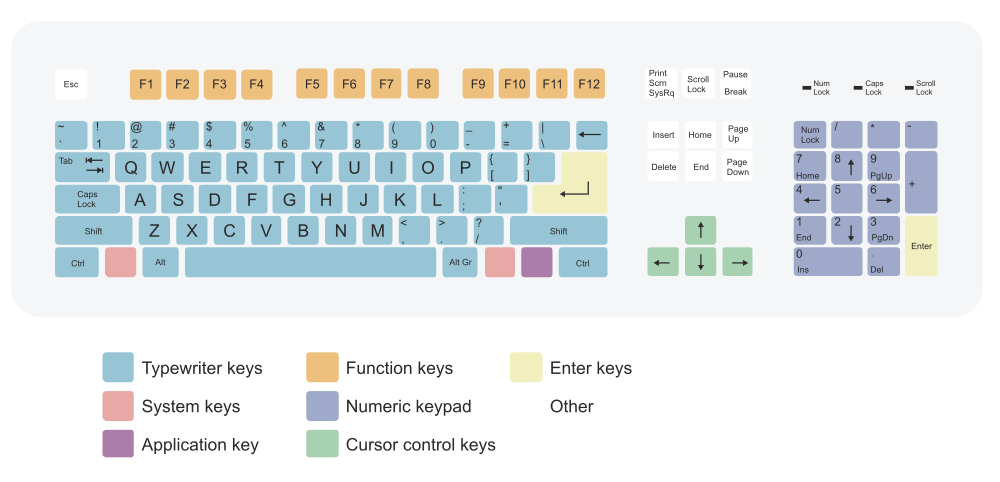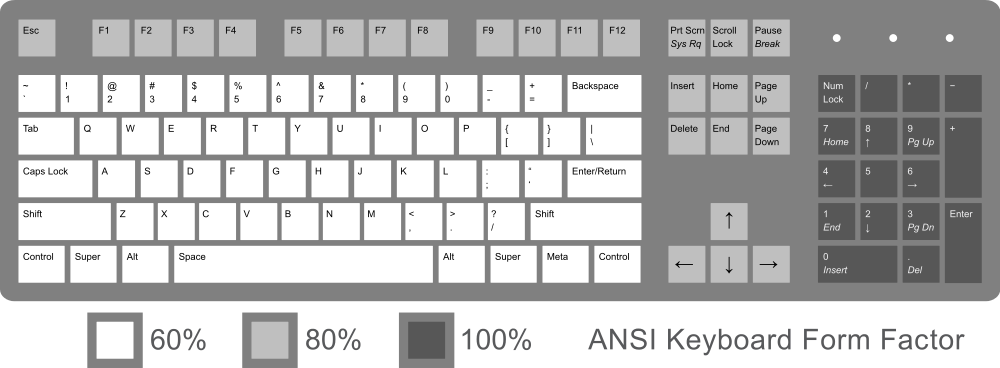Grench
Forum Addict!
- Joined
- Oct 3, 2008
- Messages
- 6,629
In my opinion, it should follow as closely as follows the standard QWERTY keyboard layout:

in terms of key positioning, but of course it cannot have all those keys. If a key exists, it's shift value should be the same as normally, e.g. the symbols on the number row.
If a key does not exist, it should be an Fn key in a position that is as near as possible to the right position.
The only reason not to follow this approach is to make it look more like the Pandora layout. E.g. it's OK to have ,.<> to the left of Z like on the Pandora.
The gaming controls have to be backwards compatible with the Pandora: the dpad should still be arrow keys, ABXY should still be home/end/pgdn/pgup, L1 has to be RSHIFT and R1 has to be RCTRL. Extra shoulder buttons should preferably be modifier keys (e.g. alt); extra gaming buttons should preferably be mapped to one of insert/delete/backspace.
All the (primary) keys that have dedicated keys on the Pandora should also have dedicated keys on the Pyra.
A dedicated TAB key should be added. A dedicated Delete key would be nice.
Some requirements that I personally don't care about, but ED has said on IRC that he cares about these:
- The keys should not be less wide than on the Pandora. They can become more rectangular though (less height) to fit a fourth row under the gaming controls.
- Standard German keyboard keys should be somewhere (in particular Ä Ö Ü ß, maybe also € µ ° §), as Fn keys
- Two shift buttons on the keyboard itself, for people who don't use the shoulder button as shift
- The total width of the device cannot increase
If a key does not exist, it should be an Fn key in a position that is as near as possible to the right position.
The only reason not to follow this approach is to make it look more like the Pandora layout. E.g. it's OK to have ,.<> to the left of Z like on the Pandora.
The gaming controls have to be backwards compatible with the Pandora: the dpad should still be arrow keys, ABXY should still be home/end/pgdn/pgup, L1 has to be RSHIFT and R1 has to be RCTRL. Extra shoulder buttons should preferably be modifier keys (e.g. alt); extra gaming buttons should preferably be mapped to one of insert/delete/backspace.
All the (primary) keys that have dedicated keys on the Pandora should also have dedicated keys on the Pyra.
A dedicated TAB key should be added. A dedicated Delete key would be nice.
Some requirements that I personally don't care about, but ED has said on IRC that he cares about these:
- The keys should not be less wide than on the Pandora. They can become more rectangular though (less height) to fit a fourth row under the gaming controls.
- Standard German keyboard keys should be somewhere (in particular Ä Ö Ü ß, maybe also € µ ° §), as Fn keys
- Two shift buttons on the keyboard itself, for people who don't use the shoulder button as shift
- The total width of the device cannot increase
This is how a proper QWERTY keyboard is laid out:
http://en.wikipedia.org/wiki/File:ANSI_Keyboard_Layout_Diagram_with_Form_Factor.svg
And yes, I realize that is a US standard not an international one.
QWERTY was an American invention: http://en.wikipedia.org/wiki/Sholes_and_Glidden_typewriter.
The international version of a proper QWERTY keyboard: http://en.wikipedia.org/wiki/File:KB_US-International.svg
An aside... Why can't we post links to .svg formatted image files?


